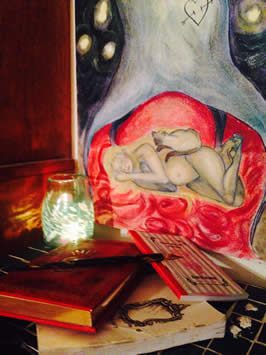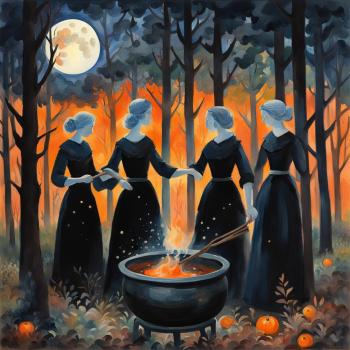This year I am participating in a writing prompt challenge on Tumblr called the 2016 Grimoire Challenge. A grimoire is a magical book with rituals for contacting spirits, spells, divination and associated lore. Also important to witches, pagans and magicians, but not grimoires proper, are pslaters (prayer books), liturgies (religious rituals), herbals, dream diaries, journals recording magical practice, and almanacs that give seasonal information. There is of course a lot of cross-over between grimoires and other kinds of magical books. The popular Book of Shadows is a bit all of the above combined.

Although grimoires on television and in movies are often pictured as extremely voluminous, most traditional grimoires are rather short. Usually they have a bit of lore or story regarding the source of the book, some instructions on basic tools and how to make them, a series of spirits and how to contact them and a few spells. There is an excellent selection of medieval grimoires on sacred-texts.com and even more on hermetic.com.
Magic books and witches have a long traditional association. In folklore and witch trial records we read that the Man in Black presented to new witches at their first sabbat ritual a big book in which to sign their names. There are any number of famous Black Books, books of planets, and medieval grimoires mentioned in witch trial records and wise-folk trial pamphlets, news articles, folk song and lore.¹
A number of well known wise women and men were known to have at least one such book often bought mail order or copied and compiled from medieval grimoires, herbals and personal practice. Some of the best examples of such grimoires used by witches and wise people for modern readers to enjoy are: Aradia the Gospel of the Witches, the Grimoire of Arthur Gauntlet, the Book of Oberon, and the Black Pullet. Also, some famous witch trial pamphlets and books about witch trials were used by witches and magicians as grimoires because information about spells and tricks was included, for example the Discoverie of Witchcraft by Reginald Scott.
If you wish to have your own old style grimoire you can copy favorite parts from other grimoires like the Greater and Lesser Keys of Solomon, or print off and photocopy material found online and in books. If you want to see something a little more current, there are a number of excellent modern grimoires made by witches and sorcerers. Most grimoires of this kind are sold in limited hard bound editions in the traditions of historical grimoires. There is something to be said about the magic of a quality made book in this day and age of newsprint paperbacks and e-readers, but these can get expensive. In the old style some of these publishers still utilize mail order, but most have websites. Rather than recommend a particular grimoire that may be sold out by the time the reader finds this article, let me reference a few grimoire publishing houses: Xoanon, Troy Books, and Scarlet Imprint. If a friend has a grimoire you can’t buy, perhaps they will let you hand copy favorite passages from it into your own.
Making Your Own

Anymore, most people privilege writing your own grimoire from scratch over the tradition of copying. While I do not think that approach is superior, it is incredibly satisfying to create and use something of your own. However, most instructions on writing a grimoire go overboard in the amount of material they suggest you cover. It becomes quite intimidating to try and include so much especially since such guides usually include liturgy, pslater, almanac, dream diary, and journal material in addition to the simpler base construction of historical grimoires. The following is my recommendation for writing a grimoire in the traditional fashion:
First make a kind of dedication, blessing and warning on the book itself. Something that says in a more poetic fashion perhaps: keep out, this book is mine. May it greatly serve only those I deem should get to see it and be useless to and repel other unwanted readers. There are a number of poetic medieval book wards here you can peruse for examples at medievalists.com.
Next write a story or poem that explains the source of the magic within. Did you learn it from a spirit guide in dreams? Did you meet a wacky old witch who taught you? Did you search a vast library of knowledge to learn it? Did you uncover it sitting and listening to nature? And where did magic itself come from before that? Was it part of the creation of the universe? Did angels or fairies teach it to humans? Does it come from deities? Put in a story about that and why that happened and for what goal. Our sense of ethics and honor usually comes from these stories we tell ourselves. This is your book and so it is okay to describe seemingly mundane events in a more mythic fashion.
The next section is usually about tools like daggers and wands. Write a little on how to make and empower them. Any symbols you like to include on them.
Then write in how to contact the spirits you know and work with in your craft: maybe your familiar, a wise ancestor, a spirit guide, fairies, angels, daemons etc. Use your personal experience about what works for you. Possibilities include: automatic writing, a prayer before sleeping for dream contact, a chant, a symbol, a combination of stones, or particular offerings. What do you do that works to contact these beings.
This is where celestial information is usually included, be it the planetary days of the week like Saturday for Saturn, Monday for Moon etc and what kinds of summonings and spells work best on those days. Or you might cover moon phases and lunar months, or solar events, something else or all of the above.
Most grimoires have some spells. I have maybe a dozen that are my go-tos for luck, money, protection, romance, fertility, healing, justice and so on. Write down the spells that get results for you and that you use often.
Not all grimoires have a correspondence list, but many do. Correspondences can be the most overwhelming aspect of writing a grimoire, but if you don’t try to cover every stone, herb, color, and everything under the sun it doesn’t have to be that bad. Include what you use regularly in your magic that gets the results you desire. I use about five stones, 10 herbs, and a few colors of candles, I don’t really need anymore than those in my book.

Divination is completely optional and not always present in the old grimoires, but I find it is important enough to modern witches that it is worth including. This is the other one that can easily get overwhelming because tarot, the most popular divination tool has 78 cards each with regular and reverse meanings. Most of us just use the tarot white book that comes with the cards or go with our gut based on the card pictures everytime we do a reading. You do not need to include tarot definitions if you work either of those ways, but you might want to include some layouts. I suggest choosing a simpler divination tool that isn’t as easy to read direct from a book or pictures on the deck if you decide to include divination. Ogham and Runes are both somewhat abstract symbols that you usually make yourself and there are about two dozen symbols in each. These could be useful to jot down meanings for. I have my own personal meanings as well as traditional meanings for all the Ogham in my grimoire with an image for each that I use everytime I do a reading.
Finish your grimoire with a closing blessing upon your magic and craft.
Viola! You have a simple and useful magic book or pile of notes. Don’t get judgy on your format for keeping papers. Some of the well known wise people had carefully kept books and others had a box of papers. Cunning Murrell, a wiseman and herb doctor had loose papers with grimoire information on them in a chest. Try to remember tradition works because people actually aren’t that different now than they were in the past. Some people kept messy piles of papers, some were tidy with perfect books, some wrote their own, some copied, some had 800 page grimoires others had just a page, some ordered theirs mail order. Our versions are binders, books ordered online, print-outs and photocopies and piles of notes to shuffle through. Do what is right for you and grimoires do not have to be intimidating.
For more ideas and to participate in a huge community of people making their own grimoires and sharing as they go along, check out the 2016 grimoire challenge; that’s what I am doing!
References
- Grimoires: A History of Magic Books by Owen Davies (back)

Patheos Pagan on Facebook.

the Agora on Facebook
Star Made Witch is published bi-monthly on alternating Mondays here on the Agora. Subscribe via RSS or e-mail!
Please use the links to the right to keep on top of activities here on the Agora as well as across the entire Patheos Pagan channel.

















